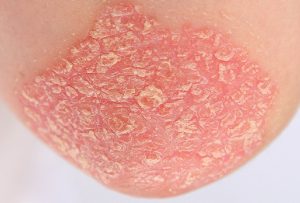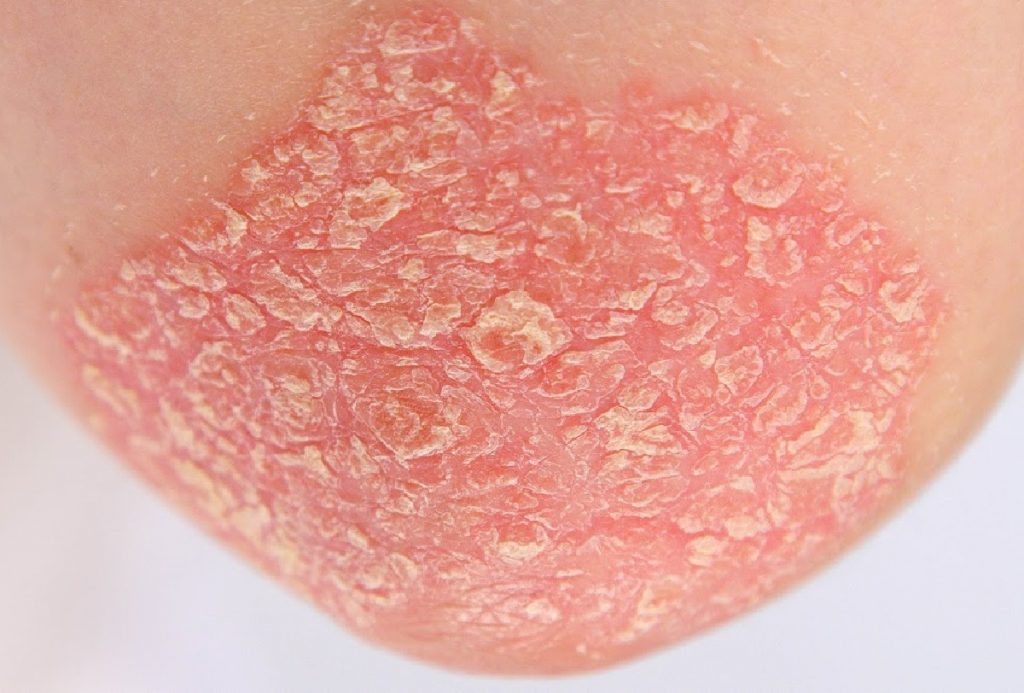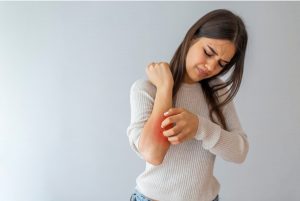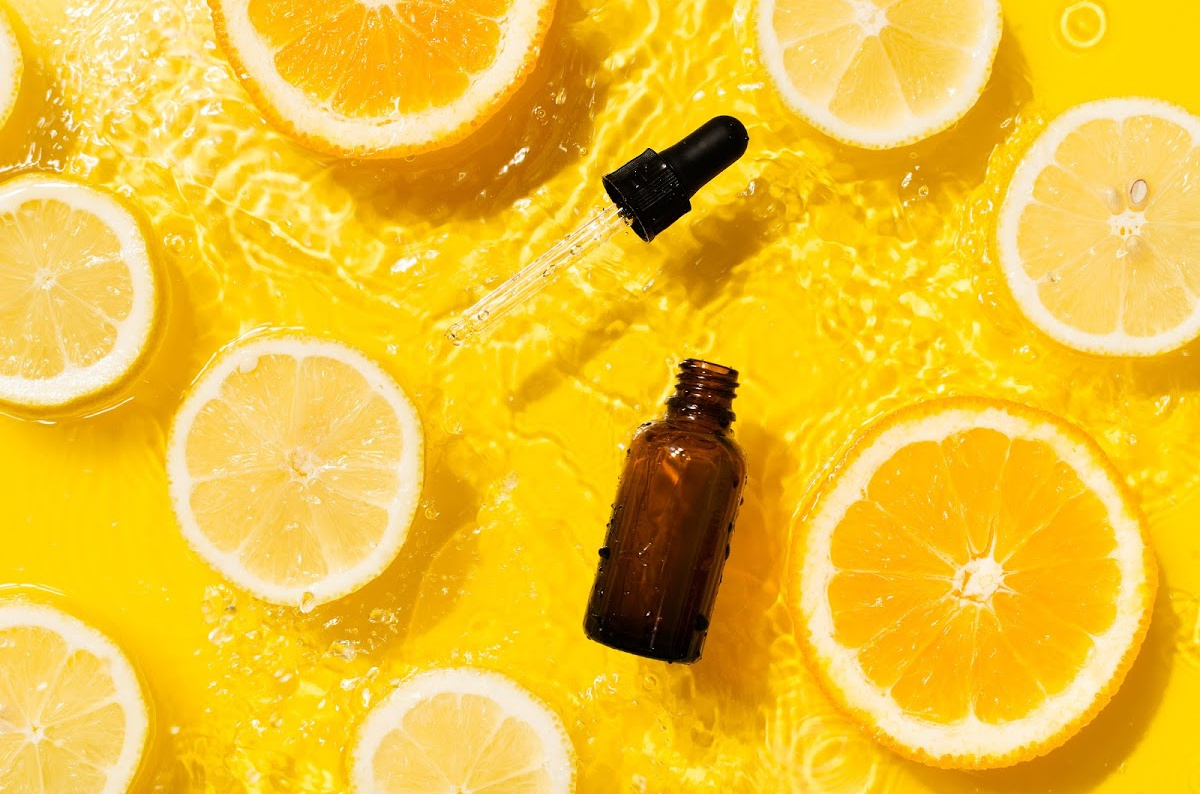What is Psoriasis?
Psoriasis is a chronic autoimmune condition that causes the rapid buildup of skin cells. The non-contagious condition affects approximately 7.4 million people nationwide. When you put that number into a percentage, however, it’s a mere 2.2% of the American population. For that small group of unlucky individuals, it makes for an absolutely miserable experience.
Symptoms

Psoriasis develops what are typically described as scales on the skin’s surface. Scales normally appear as a whitish-silver color, but quickly develop into thick, itchy patches that at times will crack and bleed. Although scales or patches typically develop on the joints (fingers, elbows, and knees), they could develop anywhere on the body, including the legs, lower back, hands, palms, feet, soles of feet, neck, scalp, and face. While these areas are the most common, it can also occur on the fingernails, toenails, genitals, and even the inside of the mouth. Sadly, scalp psoriasis affects a whopping 50% of psoriasis cases (Axe).
The most common symptoms include:
- Patches of red skin, with scales that tend to be silver or white
- Skin tightness
- Lesions that can be sensitive, itchy, and painful
- Dandruff on the scalp
- Cracked, discolored skin that bleeds
- Discoloration in the fingernails and toenails or growth of fungus
- Nails that detach from the nail beds and can be painful or bloody
- Depression and/or anxiety due to feeling embarrassed and hopeless
There are five types of psoriasis
Plaque psoriasis
The most common type, around 80% of cases are plaque psoriasis that appears as red, inflamed patches that cover areas of the skin.
Guttate psoriasis
Most common in childhood, this type typically appears as small dots on the torso, arms, and legs. This form of psoriasis has been known to be brought on by a case of strep throat.
Pustular psoriasis
More common in adults, this type causes white, blisters or pimples and typically appears on smaller areas of the body, such as the hands or feet.
Inverse psoriasis
This type has been described as areas of bright red, shiny, inflamed skin that develops under armpits or breasts, in the groin, or around skin folds in the genitals.
Erythrodermic psoriasis
The most severe and rare type of psoriasis, this form often covers large sections of the body and could be described as looking sunburned. It is often accompanied by severe itching and pain. The scales often shed in large sections or “sheets.” A person suffering with this type of psoriasis is prone to fevers and often becomes very ill with pneumonia-like symptoms. *This type can be life-threatening when left untreated.
Psoriatic Arthritis
Arthritis affects 30% or more of psoriasis sufferers as it is a result of the inflammation of the joints and occasionally the spine (Axe). People who develop psoriatic arthritis typically present with joint pain, swelling, and prolonged stiffness.
Causes of Psoriasis
To put it simply, psoriasis is the result of accelerated skin production. A normal cycle occurs when skin cells grow deep in the skin, then slowly rise to the surface and eventually fall off. The typical life cycle of a skin cell should be around one month. In people with psoriasis, however, this production process could occur in as little as a few days. Due to this irregular cycle, the skin cells do not have time to fall off. The overproduction then leads to a pile-up or buildup of skin cells, which then results in angry, irritated patches.
But why does it happen?
For some time, there has been a lot of uncertainty around what causes the overproduction of the skin cells that results in psoriasis. While many cases can be linked to unlucky genetics and the immune system, today, Functional Medicine physicians have found more contributing factors that make sense:
- Overactive immune system (autoimmune disease)
- Poor diet
- Gluten sensitivities
- Abnormal small intestine permeability
- Overgrowth of yeast in the gut
- An increased number of T cells in the blood, dermis and epidermis
- Difficulty digesting protein
- Emotional stress
- Hormonal changes
- Vitamin D deficiency
- Poor liver function
- Heavy metals exposure
The Leaky Gut Connection
Research over the last decade has found a direct link between psoriasis and intestinal permeability—also known as leaky gut. When bacteria, toxins, and partially digested protein and fat leak from the gut’s weakened lining, the body recognizes them as foreign or invaders that need to be flushed. The body then attacks them by triggering an inflammatory response. In some cases, the body will attempt to eliminate the toxins through the skin, thus triggering the autoimmune response: psoriasis.
Natural Treatments for Psoriasis
A functional medicine approach aims to treat the root of the problem. With this in mind, most naturopath practitioners do not simply wish to alleviate psoriasis symptoms—they want to eliminate the condition altogether. Naturally, the first thing they would start with is an anti-inflammatory diet (I’ll get to that below). However, there are other natural remedies that also aid in the fight against psoriasis:
1. Reduce Stress:
Stress causes inflammation, which will terrorize the immune system. Mind-body-soul therapies and stress management can really help naturally heal psoriasis. Consistent yoga, meditation, a long walk or doing any of your favorite forms of relaxation can all help you calm down. Treat yourself every day. Make sure you put aside some time for YOU.
2. Exercise:
I say it a lot and I’ll say it again because this is usually the life-altering remedy—exercise and drinking plenty of water are easy and effective ways to help treat psoriasis.
3. Aloe Vera:
It’s a common houseplant, but applying this antibacterial wonder to any flareup will pack a punch your psoriasis never saw coming. Not only will it cool the burn, but it will also reduce the redness and scales. If you’re like me and kill ALL the plants, find a bottle of 100% pure organic aloe vera gel.
4. Essential Oils as a Topical:
Tea tree, lavender, frankincense, myrrh and geranium essential oils can all help bring relief to inflamed skin.
5. Soak in the Bath:
Soaking in a lukewarm bath with Epsom and sea salts or oats can help remove the scales and patches, as well as calm any itching. *How water will further dry and irritate the skin.
6. Natural Light Therapy:
This works a couple different ways. Sunlight kills the overactive white blood cells that attack healthy skin cells and cause rapid cell growth (Sullivan). In addition, natural sunlight triggers the body to produce vitamin D, which works as an anti-inflammatory against the autoimmune. *This does not mean you should be out in the sun, all day, every day. A typical psoriasis “natural light therapy session” should only last about 10 minutes at a time. As long as your skin can tolerate the exposure, you can slowly increase your sessions by 30 seconds to 1 minute each day. You’ll still want to apply some sort of protectant to the unaffected areas of the body.
7. Change Your Diet:
We’ve already discussed that if you have a leaky gut, partially digested foods, toxins, protein and fat can seep through your intestinal lining and enter your otherwise sterile bloodstream. A clean diet full of anti-inflammatory foods is crucial and a great start to healing your gut.
Dr. Axe’s Anti-Inflammatory Psoriasis Diet
Your diet can be a treatment for psoriasis symptoms, as well as a way to prevent them altogether.
First, purge!
Avoid: Processed foods, sugars, alcohol, dairy, processed meats, fried foods, and dirty oils (like canola and vegetable). Limit or cutback your caffeine intake. In most cases, a gluten-free diet helps improve symptoms. *If you think you might have a gluten allergy or any other type of food allergy, then food allergy testing or an elimination diet is the right place to start. At Forum Health Clarkston, we have the tools to point you in the right direction.
Second, replace!
- Probiotic foods — Support digestion, remove toxins from the body, help reduce inflammation, and boost immunity with probiotic foods. Organic, raw, fermented or cultured dairy like kefir, yogurt and cultured vegetables work to give your body the beneficial bacteria and yeast it needs to be healthy.
- Fiber— Fruits, vegetables, beans and seeds are all rich in fiber and work to keep your digestive system healthy. By consuming these natural system flushers you are avoiding constipation and boosting your body’s detoxification process.
- Antioxidants — Prevent damage to your cells with top antioxidants like goji berries, wild blueberries, pecans, cilantro, and kidney beans.
- Zinc — Zinc is essential in keeping the skin healthy, and has been found to reduce pain and joint swelling. Foods like grass-fed beef, lamb, pumpkin seeds, kefir, and chickpeas are all great sources of zinc.
- Vitamin A — Orange, yellow and dark leafy green vegetables all increase vitamin A and aid in skin healing. Load up on vitamin A foods like cantaloupe, carrots, mango, tomatoes, kale, collard greens, and watermelon.
- Wild-caught fish — Vitamin D and omega-3 fatty acids are clinically proven to help fight psoriasis with their anti-inflammatory properties. Make fish loaded with vitamin D and omega-3 fatty acids like salmon, mackerel, herring, and sardines the main protein in your diet.
Final Thoughts
At Forum Health Clarkston, we’ve treated many cases of psoriasis. With our functional medicine approach, we’ve found that by giving the body the right environment, it will heal itself. We have the tools to help you find relief from your psoriasis. To find out more, join one of our monthly Meet and Greets! Call today to get started: 248-625-5143
Adrian Schirr
Forum Health Clarkston
References:
Axe, Josh M.D. (2018) “Psoriasis Diet, Essential Oils & Supplements for Natural Treatment,” Dr. Axe.
Sullivan, Debra PhD (June, 2020) ”Everything You Need to Know About Psoriasis,” Healthline.





